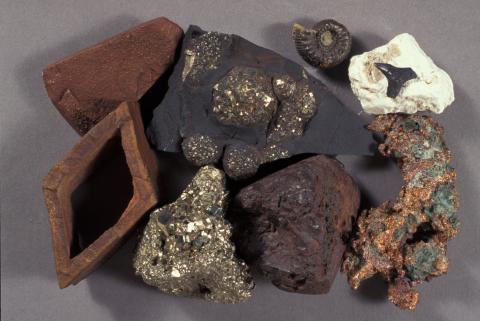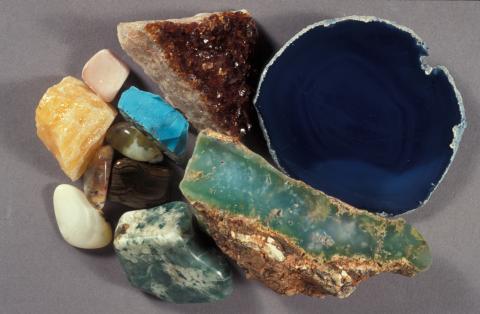Geological Collections
Introduction
Rocks and minerals may be collected for either research, education or aesthetic reasons. The colours and crystalline forms of many minerals make them particularly attractive to collectors (Figure 4).
Figure 4: (a) and (b) Examples of rocks, minerals, ores and fossils.
General rock types, their modes of formation, factors affecting deterioration and conservation were described at the beginning of this chapter. Whereas the materials described earlier in this chapter were considered stable, being used for monuments and similar structures, the many and varied samples that make up geological collections are not necessarily so.
Expressions such as ‘solid as a rock’ give the wrong impression of the stability and fragility of many materials that make up geological collections. It has been estimated for instance, that about 10% of all minerals are unstable (Howie 1992) and prone to deterioration unless adequately cared for.
One of the main purposes of this section is to alert readers of the need to care for rocks and minerals as they are often overlooked and consequently neglected because of their perceived stability.
Deterioration
The usual environmental factors, light, heat, dust, relative humidity and pollutants affect rocks and minerals in similar ways to which they affect materials considered to be more sensitive. Certain minerals, realgar (AsS) and pyrargite (Ag3SbS3) for example, are so sensitive to light that they only retain their true colours if they are stored in the dark.
In addition to light-induced damage, deterioration mechanisms for rocks and minerals include:
- physical damage of fragile specimens due to abrasion and poor handling;
- dissolution of specimens by absorption of water from the environment;
- loss of water to the environment and subsequent changes in chemical composition and properties;
- corrosion of components;
- fracturing or volatilisation of crystals by exposure to heat or cycles of hot and cold;
- chemical attack by acidic pollutants released by certain wood types such as oak, birch and chipboard used in storage cabinets and attack by agents used in cleaning and other cosmetic treatments;
- biological attack and chemical degradation under conditions of high relative humidity; and
- deterioration by radioactive decay.
Dust is potentially very damaging to minerals and rocks. In addition to disfiguring surfaces dust encourages corrosion and other reactions by providing nucleation sites for the absorption of water and pollutants from the air.
One of the problems associated with collections of rocks and minerals is the presence of impurities in some specimens. It has been suggested that the presence of impurities may account for the different behaviours of supposedly identical minerals exposed to the same conditions. Some brown topaz specimens for example, fade in light while others are stable (Nassau 1992). Thus, although guidelines can be given for the care of rock and mineral collections, these may be compromised by impurities which lead to the deterioration of some specimens.
Note that while some deterioration processes are rapid, others may only become evident after many years.
Preventive Conservation
Unlike materials made from leather, paper or a particular metal, it is not possible to recommend generalised storage and display conditions which will satisfy the conservation requirements of all rock and mineral samples. This is because of the potentially differing conditions needed to preserve the range of chemical types that may comprise such a collection.
Unfortunately in a publication of this size it is also not possible to specify all mineral types and their particular conservation requirements. As conditions for storage and display may have to be tailor-made to cater for the differing sensitivities of materials in a collection, custodians of collections will need to refer to specialised publications (Howie 1992) and contact experts in the field for more specific information.
It is obviously very important to identify the minerals and rocks that make up a collection. Unless materials are correctly identified their needs cannot be adequately catered for. Consult experts and textbooks to ensure that correct identifications are made for all specimens in a collection.
General information can be provided however, which will act as a guide for the care of these types of collections. Protect materials against:
- physical damage by abrasion or shock;
- unfavourable environments;
- inappropriate chemical treatments; and
- poor handling.
Environment
It is generally accepted that rocks and minerals are best stored in clean, dustproof surroundings in which conditions of low light and stable, moderate temperatures and relative humidity levels prevail.
Ideal conditions have been described as 50 % relative humidity at 15 – 20 °C (Price 1992). These ‘ideal’ conditions however cannot be broadly applied as deterioration mechanisms and the impact of changes in factors such as relative humidity for example, vary from mineral to mineral Apply strategies previously described to minimise damage from overexposure to light or inappropriate conditions of temperature and relative humidity (see the chapter Preventive Conservation: Agents of Decay).
Of these factors, relative humidity control is the most critical as inappropriate relative humidity conditions can lead to corrosion, gain or loss of water from crystal structures, changes from one crystal phase to another and fracturing of crystals by mechanical stresses induced by cycles of moisture gain and loss.
Store specimens prone to corrosion at relative humidity levels between 30 and 60 %. Stability is enhanced as the relative humidity is lowered. Pyrite is one example of a mineral that will oxidise unless the relative humidity is strictly controlled.
Handling
Begin the care and conservation of rocks and minerals at their point of collection. From this time ensure that:
- poor handling does not lead to physical damage;
- specimens are not ‘over-cleaned’; and
- environmental fluctuations are taken into account in transporting the specimens from the point of recovery to their new environment.
Some samples such as fluorite, wulfenite, apatites and fibrous zeolites are susceptible to physical damage. Follow the usual guidelines when handling these objects (see the chapter Handling, Packing and Storage). If delicate samples of these types are to be packaged for transport take additional care, as outlined below:
- wrap specimens in acid-free tissue and place in labelled, washed cotton or linen bags to minimise physical damage; and
- seal the wrapped specimens in polythene bags to buffer against environmental changes that may occur in transit.
For transporting particularly vulnerable specimens such as wulfenite and zeolites “open tissue-lined trays and transport by hand is perhaps the only practical method” (King 1992a).
Storage and Display
When designing storage conditions, take into account the needs of the specimens and of the people that care for them. For example, store mercury in sealed containers to prevent loss through evaporation and poisoning by inhalation of toxic vapours. Take similar care when storing radioactive materials. The degree and type of radioactive emission (alpha, beta or gamma radiation) will determine the type of storage facility required.
Use archival quality materials for any materials that are likely to come into contact with the specimens so that their chemical stabilities are not jeopardised.
Materials used in the construction of the storage building and in storage or display areas may also affect specimens. The alkaline nature of concrete for example, is likely to affect metals, sulphides and silicates. A comprehensive list of common construction materials, their likely effects on mineral specimens and recommended actions is provided in Howie (Appendix I, 1992).
Storage options for particularly sensitive specimens include:
- sealing in glass ampoules or tubes;
- refrigerated containers or environments; and
- buffered micro-environments (silica gel, zeolites).
In all cases the chemical stabilities and sensitivities of specimens must be known before undertaking a particular type of storage. Transparent containers are recommended so that the condition of samples can be monitored easily.
Treatments
General guidelines for the cleaning, ‘development’ and repair or consolidation of rocks and minerals are provided by King (1992b). Some of the key points made by King and others in the same publication are outlined below.
Cleaning
Only undertake any treatment if the mineral type and its properties are well known. Irreparable damage may occur if inappropriate treatments are applied.
Restrict cleaning of rocks and minerals to the removal of dust, dirt, clay and similar materials.
If it is necessary to immerse rocks during cleaning then ensure the liquid and the rocks are at the same temperature before immersion. This will reduce the risk of thermal shock.
Water will affect some minerals. Rock samples are generally more tolerant of water-based cleaning than are mineral specimens. Ethanol and propan-2-ol have been used to remove clay from water-soluble minerals. Some wet cleaning methods which may be useful for water-resistant samples are described earlier in the Stone section.
Dry cleaning techniques including gentle brushing, vacuuming with a soft brush attachment, air-blowing with a photographer’s hand blower and ‘airbrasive’ methods, may achieve the desired result without involving potentially damaging liquids. Airbrasive methods involve the use of fine cork or powdered walnut as abrasives.
Development
Chemicals have been used to etch surfaces, to improve the appearance of coloured crystals and to remove unwanted mineral species. Such treatments are not generally recommended and if necessary, as preparation for scientific examination for example, should only be carried out by specialists. The potential loss of information and the risk of long-term damage to the specimen outweigh the usually sought after benefits of these processes.
Repair and Consolidation
The nature of the sample and the reason for the repair will determine the type of repair technique and the adhesive used. Do not use very strong adhesives such as polyesters, cyanoacrylates (‘superglues’) and epoxy resins to repair minerals (King 1992c).
Repair techniques and suitable adhesives for the repair and consolidation of stone are described earlier in this chapter. A summary of commonly used adhesives, their constituents and features of their application is provided elsewhere (King 1992c). Note that any materials used to consolidate stone materials should have similar thermal expansion properties to the stone in question. If not, differential thermal expansion could result, leading to significant damage to the object.


